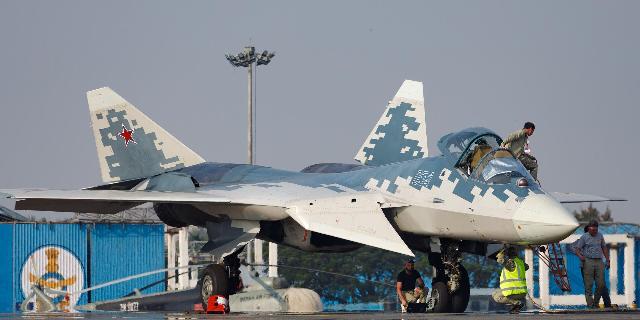TNI: Su-57 fighters will receive S-70 escort drones “Hunter-B”
Rostec develops the S-70 unmanned aircraft systemHunter-B,” writes TNI. It will serve as a support aircraft for the Su-57 fighter. Unmanned systems can perform various functions, including continuous destruction and real-time intelligence sharing.
Pilots of the Russian Aerospace Forces on fifth-generation Su—57 fighters may soon receive “faithful satellites” - escort drones that will help in completing tasks in real time.
Yuri Koptev, Managing Director of Rostec, told reporters that the state defense concern continues to develop the S-70 unmanned aerial system.“Hunter-B, which will serve as a stealth fighter support aircraft. The fidelity of such a satellite will be unquestionable, but the level of autonomy may be slightly lower than expected.
According to an Army Recognition report, “a two-seat version of the Su-57 is being developed in order to simultaneously coordinate the actions of two to four Hunters. At the same time, the unmanned systems will perform various roles, including “swarm tactics, continuous defeat, and real-time intelligence sharing.”
In addition, drones can be used “as false targets, for jamming or as striking elements.” It is also claimed that the Su-57 pilot can maintain a safe distance, “forming a combat space.”
A “faithful companion” for a two-seat aircraft only?
There is no denying that this could prove to be a significant step forward in the implementation of unmanned systems in support of manned fighter jets. However, they will be managed by a separate operator. And this highlights that escort UAVs still require significant guidance - so extensive that one pilot cannot handle it. It is unclear whether a similar American CCA combat guided drone program requires a separate operator.
If so, this would mean that the fifth-generation F-22 Raptor (Predator) and F-35 Lightning II (PredatorLightning”) will be incompatible with the CCA program.
However, since the Hunter allows the Su-57 to maintain a safe distance, the two-seat F-15EX will be able to serve as a control aircraft, keeping at a distance while the CCA drones do all the hard work.
Moreover, this may mean that the sixth-generation F-47 manned fighters from the US Air Force and the F/A-XX from the US Navy can both be produced in two-seat versions to support drones.
The “Faithful Companion” Russia: C-70 “The Hunter”
The recent announcement of the Hunter came after months of lull, interrupted only by speculation that the Su-57 could have accidentally shot down one of the drones last fall. In the months before and after the alleged incident, the Kremlin revealed some details about the drone.
As Garrison Kass previously explained on the pages of The National Interest, Russia has been developing the S-70 since 2011. Competitors MiG and Sukhoi are working on its creation, and it is being served as a sixth-generation drone.
The S-70 UAV is based on the brainchild of MiG Skat, while some of the technology coincides with the fifth-generation Su-57. It is reported that the drone weighs about twenty tons and is equipped with an AL-31 turbojet engine, the same as on the Su-27 fighter.
According to Russian data, it has a maximum speed of 1,000 kilometers and has a range of up to 6,000 kilometers. It is equipped with an electro-optical guidance system and a radio system, as well as other types of reconnaissance equipment. It also has a pair of internal compartments and can carry up to 2.8 tons of weapons.
On paper, it turns out to be a very effective satellite. The question is on the merits: how and when it will be adopted. Russia has no way to set up large-scale production of the Su-57, and it is unclear how many two-seat models are currently in service. The pace of implementation of the Hunter heavy attack drone also does not inspire confidence.
He made his debut flight, which lasted just over twenty minutes under the control of an operator, on August 3, 2019. After that, almost nothing was heard about it until the test flights in the summer of 2023, perhaps to dispel rumors and convince the public that the project is not fiction and work is really underway.
Last August, Vladimir Artyakov, Deputy General Director of Rostec, announced that the first prototype batch of the S-70 was in production at the Novosibirsk Aviation Plant named after Chkalov. However, details are still scarce, and neither the scale nor the delivery time have been announced.
The Hunter was also absent from the Army-2024 military-technical forum last summer, after which many even suggested that Artyakov was deliberately misleading. Koptev's recent comments may be the same fraud, only with new details, so that we can start guessing with renewed vigor.
Author: Peter Suciu is a writer from Michigan. During his twenty-year career in journalism, he has collaborated with four dozen magazines, newspapers and websites, published more than 3,200 articles. He regularly writes about military technology, the history of firearms, cybersecurity, politics, and international relations. Published in Forbes and Clearance Jobs.

